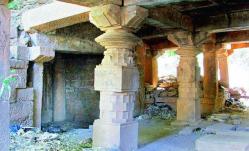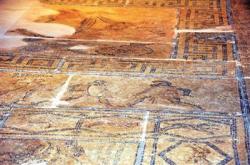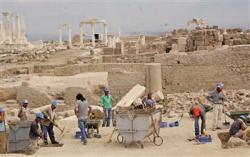INSTITUT SUPERIEUR D'ANTHROPOLOGIE
INSTITUTE OF ANTHROPOLOGY
ONLINE COURSES / COURS A DISTANCE
SUMMER TERM : JULY 2013
REGISTER NOW
PEROU - Two 400-year-old warships that sank in the Pacific Ocean after being attacked by a Dutch admiral and pirates may once again see land if researchers in Peru successfully raise them. Metal detectors and magnetometers and memoirs indicate the ships, part of a fleet that defended the Spanish crown when Peru was a colony, are some 150 kilometers (93 miles) south of the capital Lima, investigator and historian Jorge Ortiz said on Monday. The Santa Ana and the San Francisco, carrying more than 300 men, sunk in 1615 after Dutch naval officer and pirate Joris Van Spilbergen attacked them during the Eighty Years' War between Spain and revolting Dutch subjects. After Peru, Van Spilbergen sailed north and launched attacks in Mexico and later the Philippines. Ortiz said excavating the ships' remains will offer a glimpse of maritime life in the Viceroyalty of Peru, which once encompassed much of South America. Other boats from that period were destroyed in an earthquake and tsunami in 1746. Ortiz said they will likely turn up fragments of the ships, artillery, ammunition, glass and ceramics - but no sunken treasure.
http://www.reuters.com/article/2013/06/03/us-peru-culture-archaeology-idUSBRE95216V20130603
INDE –  Kurnool - The Kolanu Bharati temple, an ancient structure in Kothapalli mandal of Kurnool district, which was to be demolished on June 3, was saved from this fate by reports that appeared in Deccan Chronicle and Andhra Bhoomi last week. The local Endowment officials and people’s representatives had planned to demolish the temple and build a new structure in its place. However, on reading the newspaper reports, the Vishwa Hindu Parishad approached the district collector to take an informed decision on the same. The Collector was reportedly misled by being shown permission from the Archaeology Department. He ordered that the demolition be put on hold and has called for a meeting on June 6, where a stapathi, the person who decides on the design of temples, will also be present. The VHP says that since the temple is an ancient structure, it is essential to consult the highest temple authorities regarding demolition and construction. The central idol also can’t be moved. The Kolanu Bharati temple dates back to the Chalukyan period but is not a protected monument under the Archaeological Survey of India or the State Archaeology department. But that doesn’t give local officials the right to demolish it without permission. Meanwhile, rumours are doing the rounds in the neighbourhood that gold and silver is buried under the ancient temple.
Kurnool - The Kolanu Bharati temple, an ancient structure in Kothapalli mandal of Kurnool district, which was to be demolished on June 3, was saved from this fate by reports that appeared in Deccan Chronicle and Andhra Bhoomi last week. The local Endowment officials and people’s representatives had planned to demolish the temple and build a new structure in its place. However, on reading the newspaper reports, the Vishwa Hindu Parishad approached the district collector to take an informed decision on the same. The Collector was reportedly misled by being shown permission from the Archaeology Department. He ordered that the demolition be put on hold and has called for a meeting on June 6, where a stapathi, the person who decides on the design of temples, will also be present. The VHP says that since the temple is an ancient structure, it is essential to consult the highest temple authorities regarding demolition and construction. The central idol also can’t be moved. The Kolanu Bharati temple dates back to the Chalukyan period but is not a protected monument under the Archaeological Survey of India or the State Archaeology department. But that doesn’t give local officials the right to demolish it without permission. Meanwhile, rumours are doing the rounds in the neighbourhood that gold and silver is buried under the ancient temple.
http://www.deccanchronicle.com/130604/news-current-affairs/article/dc-report-helps-stop-temple-demolition
TURQUIE –  Orthosia / Aydin - Aydın Archaeology Museum’s ancient mosaics and excavated blocks from the ancient city of Orthosia, which include many gladiator patterns and shapes, have been presented on screens in the museum with a new project. The pieces of the gladiator blocks were unearthed in Orthosia’s ancient city, located within the borders of the Donduran Village in the Yenipazar District of Aydın. The mosaics belong to the second century after Christ. Strabon, one of the authors of the Ancient Period, mentioned Orthosia as a Karia city. The city, which was attacked by the Kimmers in the seventh century B.C., passed under the sovereignty of Lydia after the victory of Alyattes, the King of Lydia, against the Kimmers; it participated in the Ionia Union in the sixth century B.C. and then passed under the sovereignty of the Persians as the other Anatolia cities. The theatre and the Byzantine buildings still remain standing. Well-protected tombs and graves on the necropolis show qualified workmanship. The animations depict the gladiators and an ancient culture, according to Aktakka. The animations also show the fighting of gladiators. “Gladiator mosaics are the most important pieces of our museum. We have prepared these with the support of Culture and Museum General directorate,” Aktakka said. Noting that the visual effects were very important for the museum experience, Aktakka said these visual effects took the visitors back to another place in time.
Orthosia / Aydin - Aydın Archaeology Museum’s ancient mosaics and excavated blocks from the ancient city of Orthosia, which include many gladiator patterns and shapes, have been presented on screens in the museum with a new project. The pieces of the gladiator blocks were unearthed in Orthosia’s ancient city, located within the borders of the Donduran Village in the Yenipazar District of Aydın. The mosaics belong to the second century after Christ. Strabon, one of the authors of the Ancient Period, mentioned Orthosia as a Karia city. The city, which was attacked by the Kimmers in the seventh century B.C., passed under the sovereignty of Lydia after the victory of Alyattes, the King of Lydia, against the Kimmers; it participated in the Ionia Union in the sixth century B.C. and then passed under the sovereignty of the Persians as the other Anatolia cities. The theatre and the Byzantine buildings still remain standing. Well-protected tombs and graves on the necropolis show qualified workmanship. The animations depict the gladiators and an ancient culture, according to Aktakka. The animations also show the fighting of gladiators. “Gladiator mosaics are the most important pieces of our museum. We have prepared these with the support of Culture and Museum General directorate,” Aktakka said. Noting that the visual effects were very important for the museum experience, Aktakka said these visual effects took the visitors back to another place in time.
http://www.hurriyetdailynews.com/gladiators-of-aydin-to-appear-on-3d-screens.aspx?pageID=238&nID=48115&NewsCatID=375
TURQUIE –  Laodicea - The largest ancient city of Denizli, Laodicea, has been added to the World Heritage Temporary List. The head of the excavations, Professor Celal Şimşek said the ancient site had been waiting for this moment since March. UNESCO has decided to add the site to the list. The pieces found during excavations showed that the history of weaving dated back 4,000 years in Denizli, an area identified with the textile sector in modern Turkey. The excavations have continued for many years and Şimşek has been the head of the excavations for nine years. “Getting to the list means that they are accepting us,” he added. “There will be many new legislations and regulations,” Şimşek said. “As far as we have learned from Laodicea, there are three temples in this 250-by-100 meter divine area. One was dedicated to Zeus and to Athena. There is a bust of Athena on a column in the temple. We are still searching for the god of the third temple.” Laodicea is very important as it contains many clues about the economy and trade in the past. Şimşek said Laodicea’s city plan might have inspired today’s architects and city planners. “The architecture of social, religious and other buildings in the ancient city was all part of a specific system.” Archaeologists have found that the main street of Laodicea includes shops, he said. Just outside the city, archaeologists have found large burial grounds with tombs spread throughout.
Laodicea - The largest ancient city of Denizli, Laodicea, has been added to the World Heritage Temporary List. The head of the excavations, Professor Celal Şimşek said the ancient site had been waiting for this moment since March. UNESCO has decided to add the site to the list. The pieces found during excavations showed that the history of weaving dated back 4,000 years in Denizli, an area identified with the textile sector in modern Turkey. The excavations have continued for many years and Şimşek has been the head of the excavations for nine years. “Getting to the list means that they are accepting us,” he added. “There will be many new legislations and regulations,” Şimşek said. “As far as we have learned from Laodicea, there are three temples in this 250-by-100 meter divine area. One was dedicated to Zeus and to Athena. There is a bust of Athena on a column in the temple. We are still searching for the god of the third temple.” Laodicea is very important as it contains many clues about the economy and trade in the past. Şimşek said Laodicea’s city plan might have inspired today’s architects and city planners. “The architecture of social, religious and other buildings in the ancient city was all part of a specific system.” Archaeologists have found that the main street of Laodicea includes shops, he said. Just outside the city, archaeologists have found large burial grounds with tombs spread throughout.
http://www.hurriyetdailynews.com/unesco-temporary-list-includes-laodicea.aspx?pageID=238&nID=48116&NewsCatID=375